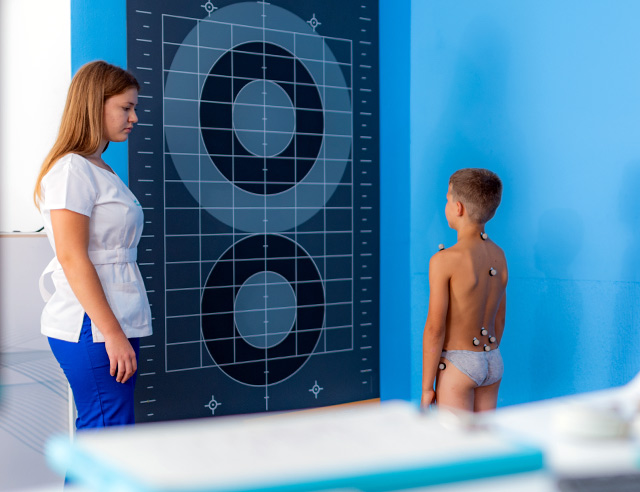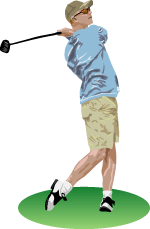One of our greatest problems in training and competing in sport is the occurrence of injuries. Injuries can sabotage the best laid plans for fitness. All too often those injuries are only treated with medicines, massage, acupuncture, manipulation, or further along injections of steroids, and finally perhaps all too often surgery.
 posture measurement
posture measurement While many people will seek advice from a sports medicine doctor, physiotherapist, osteopath or perhaps even a chiropractor, many of these practitioners will only treat the condition without actually understanding the underlying cause of the injury. You only have to look at a spine to see how its various curves may affect the pressure areas on discs, facette joints, spinal nerves, ligaments and muscles. Correct and incorrect posture can alter those curves and result in different stresses by changing the center of gravity.
Fitness trainers are in the best position to see the client's physical attributes and biomechanics. They can also anticipate problems and help prevent injuries if they know what to look for. This article will look practically at the way whole body posture can affect fitness, sporting abilities and even mood.
Posture and biomechanical imbalances
Posture starts at the head and works its way down or on the other hand starts at the feet and works its way up. Even in books looking at the progress of homo sapiens (homo erectus) in evolution, man is portrayed as somewhat hunchbacked. The head protrudes forward on the neck, the shoulders are rounded, the stomach protrudes forward with a sway back, and the knees are fully extended with the hips tilted back. As a result the feet are more likely to be pronated causing possible patellar (kneecap) tracking problems and weak VMO (vastus medialis obliquus) muscles of the thigh. Tightness and weakness in the medial gastrocnemius muscles of the calves, bunions of the big toes and clawing appearance of the other four toes may also occur. Looking at the spine this kind of posture causes many biomechanical imbalances in muscle tone resulting in many possible problems.
Effect of Nerves
Before we go into the problems of muscles we need to remember the nerve structures. Current research has reminded us that muscles and tendons are not the only things that have to stretch and slide as the body moves. Nerves have been the forgotten ingredients over many decades of sports therapy. Nerves have to be free to move with every action and before each muscle stretches the nerve or its coverings (meninges) will stretch first. The interesting thing to remember is any bruising around areas where nerves exit from the spine (such as after a whiplash injury) or where nerves pass through muscles (such as after a fall), can cause adhesions around the nerve coverings and stop the necessary movement. What happens then? Well when nerves are caught up through adhesions or scarring and prevented from moving they get very irritated. The first thing an irritated nerve does is to start to send messages to the muscles to tighten up. So the vicious cycle starts. Tight nerves lead to tight muscles. This is called Neuromeningeal tension.
We have all come across people who seem not to be able to stretch out they hamstrings no matter what. Well it's not because they are lazy or simply don't stretch enough. It's because they have neuromeningeal adhesions which cause the nerves to send signals to the muscles to tighten up at the beginning of every stretch. So the most important stretch is in fact the nerve stretch because only by loosening up those adhesions will you finally be able to stretch the muscles to their full potential. Fortunately we now have very specific stretches which can loosen those nerve adhesions in a relatively short time.
Muscle Balance
So after the stretches let's look at the muscle balance again. Starting from the top, many headaches & neck problems are related to poor balance in the nuchal (neck) muscles. Many upper arm problems often misdiagnosed as carpal tunnel, tennis elbow etc are often due to nerve related neck tension. From there poor control in the shoulder girdle with weak rhomboids can lead to rotator cuff and other shoulder problems. Chest tightness or pain may also be caused by a stooped thoracic spine with stiffness and limitation of required rotation.
Further down a sway back can cause tight hip flexor (iliopsoas) muscles, quadriceps and tension of the nerve roots leaving the lumbar spine. This can lead to increase rotation forces in the lower limb also causing more pronation at the foot. Pronation also increases the tightness in the calf muscles which in turn leads to further pronation. This biomechanical problem is often associated with tracking problems of the knee cap called Patello Femoral Dysfunction (PFD). The result is a wear and tear of the under surface of the knee cap causing pain and stiffness in the knee. The VMO's are usually wasted or underdeveloped.
As I mentioned above the problem may start at the feet. Pronated feet causing tight gastrocnemius muscles with PFD and even hip and low back problems. Let's look at a couple of examples to illustrate the above.
CASE 1:
Matthew was a 13 year old promising young sprinter sent by his coach with right knee pain. The pain was mainly around the knee cap and the boy had trouble after training and competing. He had seen a local doctor who suggested he had Osgood-Schlatter's disease. He advised rest from all sport for six months and stated that if the condition persisted the boy would have to go into a plaster cast for three to six months. The coach wanted a second opinion.
On examination Matthew was tender over the tibial tuberosity at the top of the tibial bone. This is where the growth plate of the patellar tendon attaches. The doctor's diagnosis was correct and the condition is quite common. However the doctor did not look at other biomechanical factors which may have predisposed to the condition. In fact the boy showed very tight nerve structures on initial assessment. This was probably the result of a recent growth spurt and a possible fall from a height one year earlier. In addition it was immediately apparent that he had very pronated feet. As expected his long calf muscles and his quadriceps were very tight. AM these factors resulted in excessive forces on the knee cap and the patellar tendon in particular.
Matthew was given a stretching program and referred to our podiatrist Sean Wellman for an opinion. He was placed into semi-rigid (a cheaper form of arch supports) orthoses to help stretch out the calf muscles. In the mean time he was also advised about his posture which was very poor and added to his poor biomechanics. Four weeks later his knee symptoms had improved dramatically with the degree of tenderness at the knee reduced by half.
CASE 2:
Peter was a 25 year old racing car driver. For the past two years he had been suffering from leg cramps - especially in the left leg. The cramps were worse after he had been driving and were causing him a lot of concern. Over the last 18 months he had been to other sports doctors who advised him to have physiotherapy, massage and even referred him for podiatry assessment. The diagnosis considered was Compartment Syndrome and his next alternative was surgery to split the fascia in the calves.
Examination showed tightness in the nerve structures slightly worse on the left than the right. Calf muscles were tight despite the months of treatment. Movement of the lumbar spine was reduced in both flexion and extension. No specific areas of tenderness were found in the back or the calves.
Closer questioning after the above findings revealed that Peter had been involved in a significant race track incident two and a half years ago in which his car rolled a number of times. In retrospect I was able to deduce that he had a whiplash injury at that time. As a result he developed some neuromeningeal adhesions around the nerve roots which have caused his cramps. Peter was given a program of nerve stretches with an emphasis also on stretching his calves. Two weeks later he had noticed a significant improvement in the cramps and his nerve stretch flexibility had improved by about 30 degrees.
CASE 3:
Alan was a 68 year old retired man who loved tinkering with his car and gardening. His problem was that whenever he did either of these tasks he would pay for this for days with back pain and stiffness. His back problems started many years ago when he lifted a heavy weight at work. He had played football as a youngster and had also been involved in a couple of car accidents.
Alan had been attending a local chiropractor regularly for many years. Each time however his symptoms would come back after a couple of weeks. On examination he had a stooped posture with an obviously sway back. His abdominal muscles were very weak especially his lower abdominals and obliques so important in stabilizing the pelvis. The nerve stretch was very tight causing radiating back pain at one extreme of movement. Alan was given an exercise program including nerve stretches and stomach strengthening. He phoned back a month later saying that he could not believe the improvement. He had no need for any treatment over the last month and had no pain during and after the activities which had previously troubled him.
Conclusion
In conclusion thinking Biomechanics means moving freely and preventing injury, Muscle balance, flexibility of muscles and free movement of nerve structures leads to Light Moves.
Author Information
This article was written by Sports and Orthopaedic Physician Dr George Janko - Medical Director of McKinnon Sports Medicine, one of Melbourne's best-known sports medicine centres with over 20 consultants ranging from physios, dietitians, myotherapists, osteopaths, and podiatrists. It is the only center with a fully equipped exercise physiology laboratory for Stress and Fitness testing and employs qualified exercise physiologists.
Related Pages
- Neck Pain - The Role of Neck Pillows
- Injury prevention articles.
- Stretching for sport
- Biomechanics and physics in sport
Disclaimer



